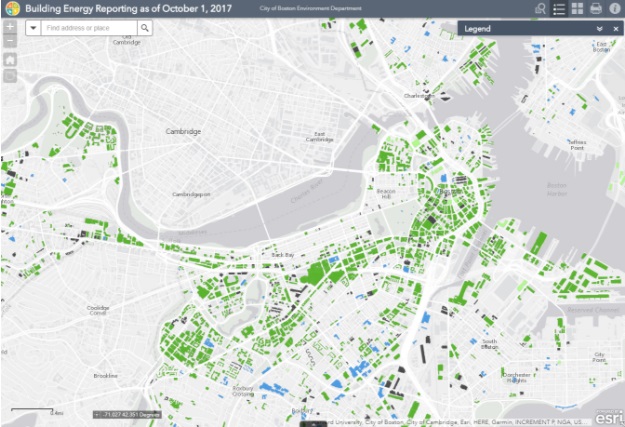
Energy and water data for over 1,800 buildings has been made available to the public as part of the third year of reporting for the Building Energy Reporting and Disclosure Ordinance.
On September 29th, 2017, the City of Boston released the third year of data for the Building Energy Reporting and Disclosure Ordinance (BERDO). Under this ordinance, all moderate and larger sized buildings in Boston must annually report their energy and water data to the City, which then organizes and publicly discloses it for everyone to see and use.
This year, BERDO covered all non-residential buildings greater than 35,000 square feet and all residential buildings that are 35,000 square feet or larger or have 35 or more units. Any tax parcel with multiple buildings that sum to 100,000 square feet or 100 units or more must also comply.
Ordinances like BERDO are important for educating building owners, managers, occupants, and the general public about the building energy consumption. Over 70% of Boston’s greenhouse gas emissions currently come from buildings, so improving building efficiency could have a significant impact on reducing Boston’s climate emissions. “This first step in reducing energy use is knowing how much you already consume,” said Mayor Walsh. “We’re working with buildings to help them understand how they can achieve savings by comparing their footprint to others, and I encourage all Bostonians to do the same.”
Using this data, buildings can be compared against each other to see which are performing the best in their type. Tenants can learn which commercial buildings are the most energy efficient when looking for new offices. Residents can learn how well their multifamily building stakes up to others. Researchers of all types gain a powerful tool in understanding Boston’s energy and climate performance.
Over 1,800 buildings across Boston submitted their energy and water data to the City in the third year of reporting. This included universities, hospitals, office buildings, warehouses, apartments, condos, and other properties. The data can be viewed on Analyze Boston, the City’s open data hub.
Also, included in this year’s disclosure is an interactive map that Bostonians can use to see their building’s energy and water usage. Check it out to see how buildings near you stack up.
The next step required by the ordinance is for buildings to show that they are making progress in cutting their carbon emissions. Buildings can comply with this requirement in several ways, including showing a 15 percent reduction in their energy usage or performing an energy audit. Energy audits provide recommendations for cost-effective measures buildings may use to cut carbon emissions.
The City of Boston is working hard to develop new programs and policies that can help to create a cleaner, greener, and more resilient Boston as part of its Climate Action Plan. If you have questions or comments about BERDO, contact Benjamin Silverman in the Environment Department at Benjamin.Silverman@boston.gov.


Recent Comments